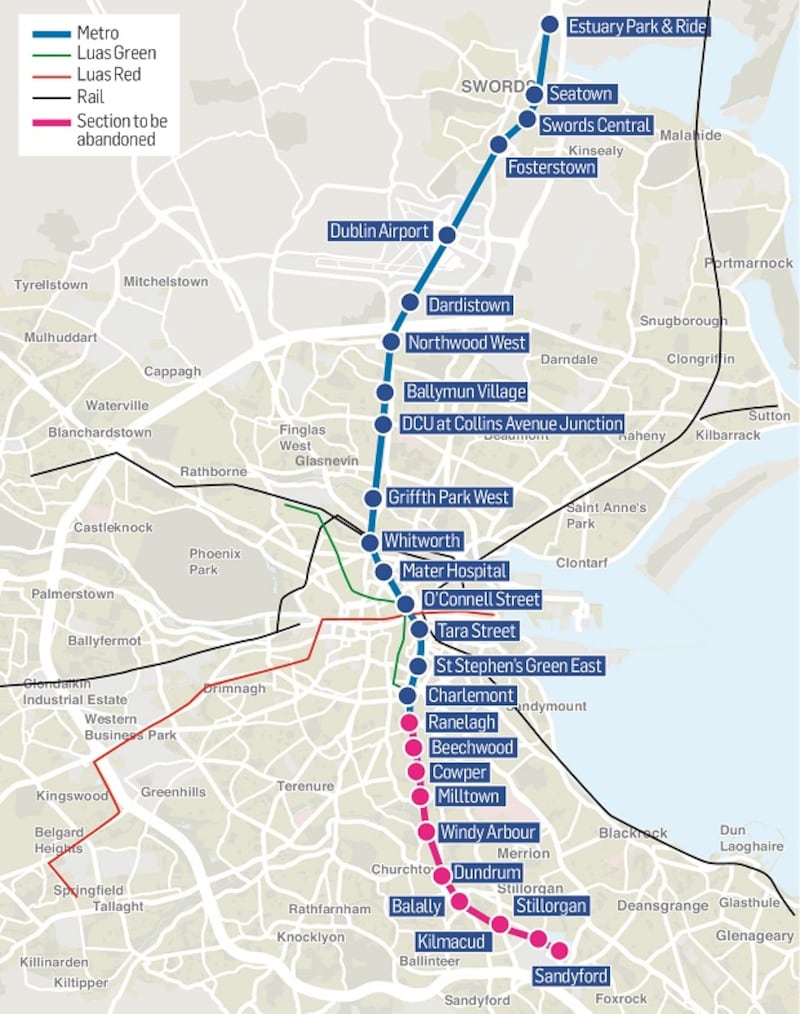The MetroLink project in south Dublin "won't be happening" given its potential to disrupt commuter flow into the city for up to four years, Minister for Transport Shane Ross has said.
He was responding to a report in The Irish Times that plans for the rail network on the southside of the city are to be scrapped.
The move, which is not expected to be officially confirmed until the end of next month, has been welcomed by local residents who have campaigned against the prospect of replacing the popular Luas line between Charlemont and Sandyford.
The reason for the expected abandonment is the potential for prolonged disruption to current services.

Appearing to confirm the decision, Mr Ross said he and the Government “will not countenance” such a level of upheaval.
“The idea that we could close a vein or an artery into a major city for four years is completely and utterly unacceptable, or for two years is unacceptable,” he said.
“I won’t countenance any project which comes up with a proposal which inconveniences commuters to that extent or to any extent . . . it won’t be happening.”
Alternative
Questions are now emerging as to what might replace the moribund proposal . An alternative is expected from the National Transport Authority (NTA) late next month.
The MetroLink plan involved the construction of new rail tracks between the airport and Charlemont station – that part is not expected to change – and the upgrading of the Luas green line between Charlemont and Sandyford, a move that would have added much-needed commuter capacity to the artery.
However, political pressure had been brought to bear on the proposal following considerable local agitation. This was particularly concentrated around the Beechwood stop where a problematic closure of a small link road had been proposed with resulting traffic diversions in and around Ranelagh.
Potential solutions included the extension of the train tunnel past the area. However, these were not considered sufficient to address concerns, particularly commuter disruption, estimated at between two and four years. The additional tunnelling was likely to add more than €100 million to the cost of the €3 billion line.
The apparent decision to return to the drawing board was met with enthusiasm in the area. Green party leader Eamon Ryan said there is a need to see the engineering details that prompted the Government's change of position.
Abandoning the light-rail solution after only 14 years and ripping up the Luas will be very disruptive for 45,000 daily commuters
“They need to change the route, not abandon it,” he said, adding that further tunnelling options, branching out in the direction of UCD or toward Harold’s Cross, warranted consideration.
“The real cost is putting the tunnelling machinery in the ground. Once you have it running, the cost to continue it is not huge,” he said.
Campaign group
The local campaign group Rethink Metrolink, which had energetically fought the plans, agreed there are "much more sensible" routes travelling either southwest to Rathmines, Harold's Cross, Terenure and Rathfarnham; or east through UCD.
“Abandoning the light-rail solution after only 14 years and ripping up the Luas will be very disruptive for 45,000 daily commuters,” it said.
Meanwhile, with an eye firmly on their north Dublin constituencies, Fine Gael TDs Alan Farrell and Noel Rock have insisted the Metro project should be divided into two distinct development phases so as not to undermine the link between the airport and the city.
“Anything less than this would be tantamount to these State bodies failing the people of north Dublin, residents in Swords and its surrounding communities, and Dublin as a whole,” Mr Farrell said in a statement.












